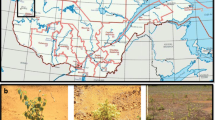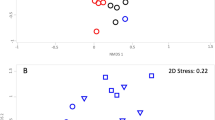Abstract
Mine tailing deposits in semiarid and arid environments frequently remain devoid of vegetation due to the toxicity of the substrate and the absence of a diverse soil microbial community capable of supporting seed germination and plant growth. The contribution of the plant growth promoting bacterium (PGPB) Azospirillum brasilense Sp6 to the growth of quailbush in compost-amended, moderately acidic, high-metal content mine tailings using an irrigation-based reclamation strategy was examined along with its influence on the rhizosphere bacterial community. Sp6 inoculation resulted in a significant (2.2-fold) increase in plant biomass production. The data suggest that the inoculum successfully colonized the root surface and persisted throughout the 60-day experiment in both the rhizosphere, as demonstrated by excision and sequencing of the appropriate denaturing gradient gel electrophoresis (DGGE) band, and the rhizoplane, as indicated by fluorescent in situ hybridization of root surfaces. Changes in rhizosphere community structure in response to Sp6 inoculation were evaluated after 15, 30, and 60 days using DGGE analysis of 16S rRNA polymerase chain reaction amplicons. A comparison of DGGE profiles using canonical correspondence analysis revealed a significant treatment effect (Sp6-inoculated vs. uninoculated plants vs. unplanted) on bacterial community structure at 15, 30, and 60 days (p < 0.05). These data indicate that in an extremely stressed environment such as acid mine tailings, an inoculated plant growth promoting bacterium not only can persist and stimulate plant growth but also can directly or indirectly influence rhizobacterial community development.




Similar content being viewed by others
References
Amman RI, Binder BJ, Olson RJ, Chisholm SW, Devereux R, Stahl DA (1990) Combination of 16S rRNA-targeted oligonucleotide probes with flow cytometry for analyzing mixed microbial populations. Appl Environ Microbiol 56:1919–1925
Ausubel FM, Brent R, Kingston RE, Moore DD, Seidman JG, Smith JA, Struhl K (eds) (1995) Current protocols in molecular biology. John Wiley & Sons, Inc, Hoboken, pp 2.7.3–2.7.6
Bacilio M, Rodriguez H, Moreno M, Hernandez J-P, Bashan Y (2004) Mitigation of salt stress in wheat seedlings by a gfp-tagged Azospirillum lipoferum. Biol Fertil Soils 40:188–193
Barbieri P, Galli E (1993) Effect on wheat root development of inoculation with an Azospirillum brasilense mutant with altered indole-3-acetic acid production. Res Microbiol 144:69–75
Bashan Y (1999) Interactions of Azospirillum spp. in soils: a review. Biol Fertil Soils 29:246–256
Bashan Y, de-Bashan LE (2005) Bacteria/Plant growth-promotion. In: Hillel D (ed) Encyclopedia of soils in the environment, vol 1. Elsevier, Oxford, pp 103–115
Bashan Y, de-Bashan LE (2005) Fresh-weight measurements of roots provide inaccurate estimates of the effects of plant growth-promoting bacteria on root growth: a critical examination. Soil Biol Biochem 37:1795–1804
Bashan Y, Hernandez J-P, Leyva LA, Bacilio M (2002) Alginate microbeads as inoculant carrier for plant growth-promoting bacteria. Biol Fertil Soils 35:359–368
Bashan Y, Holguin G, de-Bashan LE (2004) Azospirillum-plant relationships: physiological, molecular, agricultural, and environmental advances (1997-2003). Can J Microbiol 50:521–577
Baudoin E, Nazaret S, Mougel C, Ranjard L, Moënne-Loccoz Y (2009) Impact of inoculation with the phytostimultory PGPR Azospirillum lipoferum CRT1 on the genetic structure of the rhizobacterial community of field-grown maize. Soil Biol Biochem 41:409–413
Belimov A, Dietz K-J (2000) Effect of associative bacteria on element composition of barley seedlings grown in solution culture at toxic cadmium concentrations. Microbiol Res 155:113–121
Castro-Sowinski S, Herschkovitz Y, Okon Y, Jurkevitch E (2007) FEMS Microbiol Lett 276:1–11
Chiu KK, Ye ZH, Wong MH (2006) Growth of Vetiveria zizanioides and Phragmities australis on Pb/Zn and Cu mine tailings amended with manure compost and sewage sludge: a greenhouse study. Bioresour Technol 97:158–170
Colores GM, Macur RE, Ward DM, Inskeep WP (2000) Molecular analysis of surfactant-driven microbial population shifts in hydrocarbon-contaminated soil. Appl Environ Microbiol 66:2959–2964
Creus CM, Graziano M, Casanovas EM, Pereyra MA, Simontacchi M, Puntarulo S, Barassi CA, Lamattina L (2005) Nitric oxide is involved in the Azospirillum brasilense-induced lateral root formation in tomato. Planta 221:297–303
Creus CM, Sueldo RJ, Barassi CA (1997) Shoot growth and water status in Azospirillum-inoculated wheat seedlings grown under osmotic and salt stresses. Plant Physiol Biochem 35:939–944
Daims H, Stoecker K, Wagner M (2005) Fluorescence in situ hybridization for the detection of prokaryotes. In: Osborn AM, Smith CJ (eds) Molecular Microbial Ecology. Taylor & Francis Group, New York, pp 213–222
de-Bashan LE, Antoun H, Bashan Y (2005) Cultivation factors and population size control uptake of nitrogen by the microalgae Chlorella vulgaris when interacting with the microalgae growth-promoting baterium Azospirillum brasilense. FEMS Microbiol Ecol 54:197–203
de-Bashan LE, Antoun H, Bashan Y (2008) Involvement of indole-3-acetic-acid produced by the growth-promoting bacterium Azospirillum spp. in promoting growth of Chlorella vulgaris. J Phycol 44:938–947
de-Bashan LE, Bashan Y (2004) Recent advances in removing phosphorus from wastewater and its future use as fertilizer (1997-2003). Water Res 38:4222–4246
Dimkpa C, Weinand T, Asch F (2009) Plant-rhizobacteria interactions alleviate abiotic stress conditions. Plant Cell Environ 32:1682–1694
Dobbelaere S, Croonenborghs A, Thys A, Vande Broek A, Vanderleyden J (1999) Phytostimulatory effect of Azospirillum brasilense wild type and mutant strains altered in IAA production on wheat. Plant Soil 212:155–164
Felici C, Vettori L, Giraldi E, Forino LMC, Toffanon A, Tagliasacchi AM, Nuti M (2008) Single and co-inoculation of Bacillus subtilis and Asospirillum brasilense on Lycopersicon esculentum: effects on plant growth and rhizosphere microbial community. Appl Soil Ecol 40:260–270
Ferris MJ, Muyzer G, Ward DM (1996) Denaturing gradient gel electrophoresis profiles of 16S rRNA-defined populations inhabiting a hot spring microbial mat community. Appl Environ Microbiol 62:340–346
Franke-Whittle I, Klammer S, Insam H (2005) Design and application of an oligonucleotide microarray for the investigation of compost microbial communities. J Microbiol Methods 62:37–56
Gonzalez-Chavez MC, Carrillo-Gonzalez R, Gutierrez-Castorena MC (2008) Natural attenuation in a slag heap contaminated with cadmium: the role of plants and arbuscular mycorrhizal fungi. J Hazard Mater. doi:10.1016/j.jhazmat.2008.04.110
Grandlic CJ, Mendez MO, Chorover J, Machado B, Maier RM (2008) Plant growth-promoting bacteria for phytostabilization of mine tailings. Environ Sci Technol 42:2079–2084
Grandlic CJ, Palmer MW, Maier RM (2009) Optimization of plant growth-promoting bacteria-assisted phytostabilization of mine tailings. Soil Biol Biochem 41:1734–1740
Hammer Ø, Harper DAT, Ryan PD (2001) PAST: Palaeontological Statistics software package for education and data analysis. Palaeontol Electronica 4:9
Herschkovitz Y, Lerner A, Davidov Y, Okon Y, Jurkevitch E (2005) Azospirillum brasilense does not affect population structure of specific rhizobacterial communities of inoculated maize (Zea mays). Environ Microbiol 7:1847–1852
Herschkovitz Y, Lerner A, Davidov Y, Rothballer M, Okon Y, Jurkevitch E (2005) Inoculation with the plant-growth-promoting rhizobacterium Azospirillum brasilense causes little distrurbance in the rhizosphere and rhizoplane of maize (Zea mays). Microb Ecol 50:277–288
Iverson SL, Maier RM (2009) Effects of compost on colonization of roots of plants grown in metalliferous mine tailings, as examined by fluorescence in situ hybridization. Appl Environ Microbiol 75:842–847, PMID: 19047384
Lee KJ, Gaskins MH (1982) Increased root exudation of 14C-compounds by sorghum seedlings inoculated with nitrogen-fixing bacteria. Plant Soil 69:391–399
Legendre P, Legendre L (1998) Numerical ecology. Elsevier, Amsterdam
Lerner A, Herschkovitz Y, Baudoin E, Nazaret S, Moenne-Loccoz Y, Okon Y, Jurkevitch E (2006) Effect of Azospirillum brasilense inoculation on rhizobacterial communities analyzed by denaturing gradient gel electrophoresis and automated ribosomal intergenic spacer analysis. Soil Biol Biochem 38:1212–1218
McCutcheon SC, Schnoor JL (2003) Phytoremediation: transformation and control of contaminants. Wiley-Interscience, USA, p 1024
Mendez MO, Glenn EP, Maier RM (2007) Phytostabilization potential of quailbush for mine tailings: growth, metal accumulation, and microbial community changes. J Environ Qual 36:245–253
Mendez MO, Maier RM (2008) Phytoremediation of mine tailings in temperate and arid environments. Rev Environ Sci Biotechnol 7:47–59
Mendez MO, Neilson JW, Maier RM (2008) Characterization of a bacterial community in an abandoned semiarid lead-zinc mine tailing site. Appl Environ Microbiol 74:3899–3907
Molina-Favero C, Creus CM, Simontacchi M, Puntarulo S, Lamattina L (2008) Aerobic nitric oxide production by Azospirillum brasilense Sp245 and its influence on root architecture in tomato. Mol Plant-Microb Interact 21:1001–1009
Muyzer G, de Waal EC, Uitterlinden AG (1993) Profiling of complex microbial populations by denaturing gradient gel electrophoresis analysis of polymerase chain reaction-amplified genes encoding for 16S rRNA. Appl Environ Microbiol 59:695–700
Palmer MW (1993) Putting things in even better order: the advantages of canonical correspondence analysis. Ecology 74:2215–2230
Petrisor I, Dobrota S, Komnitsas I, Lazar K, Kuperberg JM, Serban M (2004) Artificial inoculation–perspectives in tailings phytostabilization. Int J Phytoremediat 6:1–15
Pilon-Smits E (2005) Phytoremediation. Annu Rev Plant Biol 56:15–39
Rosario K, Iverson SL, Henderson DA, Chartrand S, McKeon C, Glenn EP, Maier RM (2007) Bacterial community changes during plant establishment at the San Pedro river mine tailings site. J Environ Qual 36:1249–1259
Saad MS, Ali Sabuddin AS, Yunus AG, Shamsuddin ZH (1999) Effects of Azospirillum inoculation on sweet potato grown on sandy tin-tailing soil. Commun Soil Sci Plan 30:1583–1592
ter Braak CJF, Wiertz J (1994) On the statistical analysis of vegetation change: a wetland affected by water extraction and soil acidification. J Veg Sci 5:361–372
Ye ZH, Yang ZY, Chan GYS, Wong MH (2001) Growth response of Sesbania rostrata and S. cannabina to sludge-amended lead/zinc mine tailings. A greenhouse study. Environ Int 26:449–455
Zhuang X, Chen J, Shim H, Bai Z (2007) New advances in plant growth-promoting rhizobacteria for bioremediation. Environ Int 33:406–413
Acknowledgments
We thank Julia Neilson, Antje Legatzki, Sadie Iverson, Christopher Grandlic, and Fernando Solis for numerous helpful discussions and Alexis Valentin-Vargas for enumeration of neutrophilic heterotrophs. We also thank Anton Hartmann and Michael Schmidt from the German Research Center for Environmental Health, Münich, Germany, for advising on FISH development. We thank Veerle Keijers and Jos Vanderleyden at the Katholieke Universiteit Leuven in Leuven, Belgium, for providing A. brasilense Sp6. This research was supported by grant 2 P42 ES04940-11 from the National Institute of Environmental Health Sciences Superfund Basic Research Program, National Institutes of Health (USA), and by grant 50052-Z from Consejo Nacional de Ciencia y Tecnologia- Basic Research (CONACYT) Mexico.
Author information
Authors and Affiliations
Corresponding author
Rights and permissions
About this article
Cite this article
de-Bashan, L.E., Hernandez, JP., Nelson, K.N. et al. Growth of Quailbush in Acidic, Metalliferous Desert Mine Tailings: Effect of Azospirillum brasilense Sp6 on Biomass Production and Rhizosphere Community Structure. Microb Ecol 60, 915–927 (2010). https://doi.org/10.1007/s00248-010-9713-7
Received:
Accepted:
Published:
Issue Date:
DOI: https://doi.org/10.1007/s00248-010-9713-7




